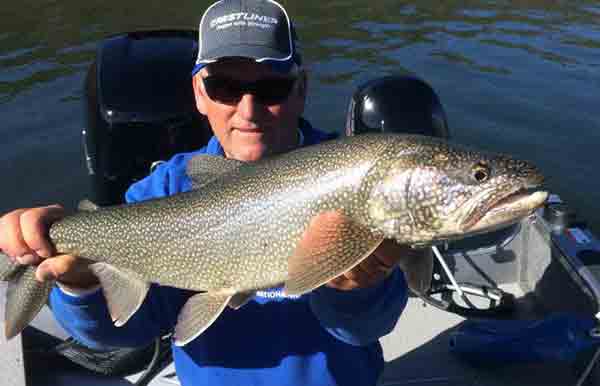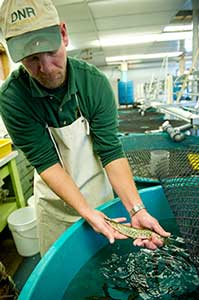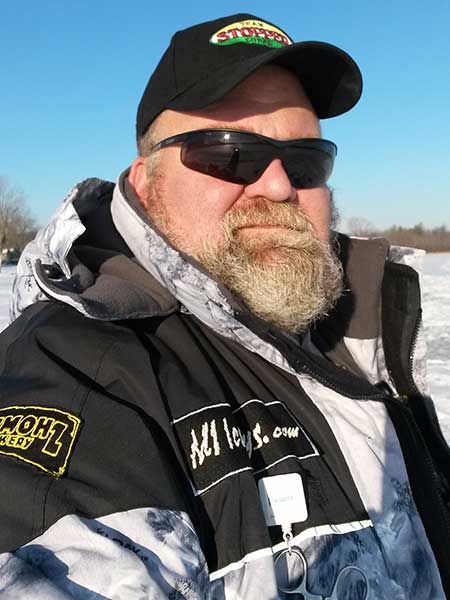- Details
(Provided by All Creation Media)
 Understanding Gamefish Strike Zones
Understanding Gamefish Strike Zones
Many anglers agonize over finding the hot lure or perfect color pattern for the conditions at hand, but veteran guide Bernie Keefe argues they'd catch more fish by focusing on strike zones instead.
"A strike zone is the area in which fish will respond positively to your presentation, and the size of these areas changes frequently, even during the course of a day on the water," he explains.
While Keefe concentrates most of his time connecting clients with feisty trout including lakers, browns and 'bows, along with Kokanee salmon, he's also a veteran walleye and pike fan, and says the strike zone concept applies to virtually any gamefish.
"Same with technique," he says. "Strike zones are a big deal whether you're casting, jigging or trolling."
- Details
(Provided by Michigan DNR)
 Trout Fishing Locations Added to Michigans Trout Trails ApplicationWhat angler wouldn't like inside information on potentially new hot spots for Michigan trout fishing?
Trout Fishing Locations Added to Michigans Trout Trails ApplicationWhat angler wouldn't like inside information on potentially new hot spots for Michigan trout fishing?
A second round of quality trout streams and lakes accessible to anglers has been added to the Michigan DNR online Trout Trails application to help with that. Trout Trails is a comprehensive map featuring fisheries biologist-verified trout waters that are often lesser known, but considered outstanding destination points.
This is the second phase of Trout Trails locations revealed, with more than 60 additional sites added to the application. That brings the total locations highlighted close to 200. These newly added sites are spread out over the western and central Upper Peninsula, northern Lower Peninsula and southwestern and southeastern Lower Peninsula.
Additional locations will be added over time to comprehensively provide statewide coverage of these types of waters.
Interested anglers should visit Michigan.gov/trouttrails, the Web-based Trout Trails application. Please note, Trout Trails is not a downloadable app, but it is compatible with all types of electronic devices.
Each of the nearly 200 destinations feature extensive information, including trout species available, regulations, presence of stocked or naturally reproducing fish, driving directions (with a link to Google maps), area lodging, restaurants, and noteworthy information (such as presence of fast water, canoe/kayak/tube accessibility, best times to fish, what bait or lure to use, etc.).
"These latest additions to the Trout Trails map continue to make it a go-to tool for anglers looking to plan future fishing trips," said Suzanne Stone, education and outreach specialist with the DNRs Fisheries Division. Michigan's trout fishing is world-class, and we feel this application makes it even easier to head out and experience fantastic fishing and find new fishing spots."
It should be noted that information about each Trout Trails site also is available in a printable format.
- Details
(Provided by Michigan DNR)
 Muskie FingerlingsThe Michigan DNR recently stocked 27,449 muskellunge fingerlings into 17 water bodies located throughout the state, in an effort to further enhance Michigan's world-class fisheries.
Muskie FingerlingsThe Michigan DNR recently stocked 27,449 muskellunge fingerlings into 17 water bodies located throughout the state, in an effort to further enhance Michigan's world-class fisheries.
Michigan is home to two strains of naturally producing muskellunge: Great Lakes and northern. The DNR has reared muskellunge in its hatcheries since the 1950s. While the hatchery program initially focused on the northern muskellunge strain, it has shifted focus in recent years to the Great Lakes strain, as it is native to Michigan and widely distributed in water bodies throughout the Lower Peninsula and eastern region of the Upper Peninsula.
Since 2011 the DNR has collected eggs and milt (sperm) from adult muskellunge in the Lake St. Clair/Detroit River system. The offspring then are reared at Wolf Lake State Fish Hatchery in Mattawan. This hatchery is the only facility in the state currently capable of rearing this species. After hatching, the muskellunge are started in hatchery tanks and then transferred to outside ponds after a few months for grow-out.
Historically, muskellunge were reared by stocking fry in ponds and allowing them to grow by eating natural food, similar to how the DNR currently rears walleye. Because of the highly cannibalistic nature of muskellunge, the success of these rearing efforts was highly variable and often produced low numbers. Current rearing efforts at Wolf Lake State Fish Hatchery produce a much higher survival rate and more stable, predictable production.
"We're making great headway in our efforts to increase muskellunge fishing opportunities for anglers," said DNR fisheries biologist Matt Hughes, who oversees the rearing program at Wolf Lake State Fish Hatchery. "With time and experience, we've stabilized and increased production so more and more water bodies can be stocked."
- Details
D&R Sports Center in Kalamazoo will host a free, two-day Ice Fishing Show Dec. 5-6.
Ice fishing pros Chas Thompson and his MI Ice Guys team, panfish expert Bill Ferris, and walleye pro Mike Schneider will share their experience, tips and tricks for successful ice fishing.
Chas Thompson and the Ice Guys will offer insights into modern ice fishing techniques. Bill Ferris, Ionia, Mich., who has been ice fishing for bluegills, crappie, perch and walleye through the ice for many years, has fished numerous lakes throughout Michigan. He will talk about techniques that will help you catch more fish for the pan. He will cover equipment, such as rods, reels, jigs, baits and the ins and outs on using electronics. Schneider, a member of the Rapala Ice Force Pro Staff, is an instructor with the Mark Martin Ice Fishing Vacation School.
- Details
By Louie Stout
Most Michiana anglers are loyal to one species of fish, spending the majority of their time targeting just bass, or bluegills, or walleye, or salmonids. Quite a few are devout trout fly fishers, too.
If youre among the group that just likes to catch fish, I came across something the other day that might arouse your interest inland lake trout fishing.
The DNR in both states have stocked rainbows in a few select lakes for years but you dont hear about many people fishing for them.






